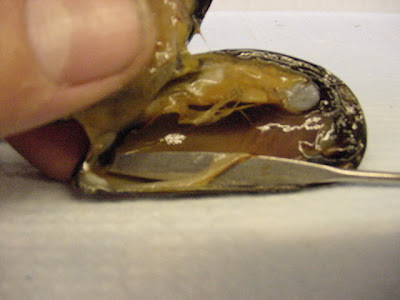
In Malaysia, the green-lipped mussel Perna viridus (Linnaeus), is a commercial bivalve species although it is not as popular as the cockle Anadara granosa among the local people. Marine mussels have been used and proposed as biomonitors for heavy metals since two decades ago (Goldberg 1975). Their potential for biomonitoring purposes is due to their wide geographical distribution, sedentary lifestyle, reasonable abundance and availability throughout the year, easily identified and sampled, bioaccumulative and correlative properties with the average pollutants of the environment, torelance to natural environmental fluctuations and pollution, and ecological and economical importance (Phillips and Rainbow 1993).
In Malaysia, P.viridis had been suggested as a potential biomonitoring agent for heavy metals in the west coast of Peninsular Malaysia (Ismail et al.,2000) since its metal concentrations (Cd, Cu and Pb) showed good correlations with those found in its environment (Yap et al., 2002) and low genetic differentiation was found among its different geographical populations in the west coast of the peninsula (Yap et al.,2002).
Since there is a possibility of metal distribution in different soft tissues of P.viridis (Ismail et al,1999), only the mantle tissue of the mussels was analyzed from all populations in order to have a reliable comparison among the different locations. The soft tissue mantle was selected because it is an easily dissectable organ and is one of the soft tissues comsumed by humans.
 Mantle tissue (under the metal spatula).
Mantle tissue (under the metal spatula).The Hg levels in Kg Pasir Puteh, Johor and Pantai Lido, Johor were higher than other populations as 33.8 µg/kg wet weight and 32.5µg/kg wet weight, respectively.(Yap et al., 2003). High levels of Cd, Cu, Pb and Zn in P.viridis had also been reported by Ismail et al. (2000) at the the Kg Pasir Puteh. Similarly, Moradi et al.(1999) reported an elevation level of polycyclic aromatic hydrocarbons in this mussel species at Kg.Pasir Puteh. Yap et al. (2002) reported high levels of Cd, Cu, Pb and Zn in the soft tissue of P.viridis and sediment at the same site. These levels were most probably due to anthropogenic inputs in the vicinity of the sampling sites. The sampling site at Kg Pasir Puteh was characterized as having received a variety of anthropogenic activities such as domestic wastes, industrial effluents and marine activities.
 Map showing sampling station of the green lipped mussel at Kg Pasir Puteh(Port, industry and urban area).
Map showing sampling station of the green lipped mussel at Kg Pasir Puteh(Port, industry and urban area).Hg level : 33.8 ± 5.51(19.7-50.0)µg/kg wet weight ± SE.
Cd level : 0.14(0.09-0.23)µg/g wet weight
Cu level : 3.42(1.88-5.93)µg/g wet weight
Pb level : 1.49(0.61-2.18)µg/g wet weight
Zn level : 21.9(15.4-26.9)µg/g wet weight
Shell length : 61.1(51.8-91.3) mm
 Map showing sampling station of the green lipped mussel at Pantai Lido(Port, industry and urban area).
Map showing sampling station of the green lipped mussel at Pantai Lido(Port, industry and urban area).Hg level : 32.5 ± 7.30(20.2-39.8)µg/kg wet weight ± SE.
Cd level : 0.12(0.06-0.26)µg/g wet weight
Cu level : 1.60(0.88-3.13)µg/g wet weight
Pb level : 0.69(0.31-1.53)µg/g wet weight
Zn level : 19.9(11.6-28.0)µg/g wet weight
Shell length : 64.6(53.4-82.4) mm
 Map showing sampling station of the green lipped mussel at Tg Kupang (Port and aquaculture area).
Map showing sampling station of the green lipped mussel at Tg Kupang (Port and aquaculture area). Hg level: 16.6 ± 3.73(10.7-23.5)µg/kg wet weight ± SE.
Shell length : 83.6(70.0-90.0) mm
From the public health point of view, it was found that the heavy metal levels found in the mussels collected from the west coast of Peninsular Malaysia were lower than the maximum Permissible limits set by Malaysian Food Regulation (1985)
Hg level : 500 µg/kg wet weight
Cd level : 1.00 µg/g wet weight
Cu level : 30.0 µg/g wet weight
Pb level : 2.00 µg/g wet weight
Zn level : 100 µg/g wet weight
Yap et al.(2003) reported the consumption of P.viridis from the west coast of Peninsular Malaysia is not a health hazard as far as contamination by Hg is concerned although this could depend also on the amount of mussels being consumed. By using the biomonitor P.viridis, anthropogenic Hg, Cd, Cu, Pb and Zn contamination in the waters of the west coast of the Peninsular Malaysia was found not to be serious and this will give confidence to the expansion of mussel aquacultural operations along the west coast of the peninsula.
Future monitoring is still much needed since the accumulation of Hg can be affected by age of mussels, season, reproductive cycles and other intrinsic factors (Lobel, 1989). Yap et al. (2003) suggested that P.viridis as a suitable bio-monitoring agent for this metal in the waters off the west coast of Peninsular Malaysia.
Future studies should concentrate on the relative importance of water, sediment and food in the accumulation of metals by the mussels.
REFERENCES:
Yap, C.K., Ismail, A. and Tan,S.G.(2003). Mercury Levels in the Green Lipped Mussel Perna viridis (Limnaeus) fronm the West Coast of Peninsular Malaysia. Bulletin of Environmental Contamination and Toxicology 71:570-576.
Yap, C. K. (1999). Accumulation and distribution of heavy metals in green-lipped mussel Perna viridis (Linnaeus) from the west coast of Peninsular Malaysia. Master’s thesis, Department of Biology, Faculty of Science and Environmental Studies,Universiti Putra Malaysia
No comments:
Post a Comment